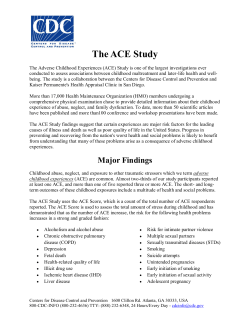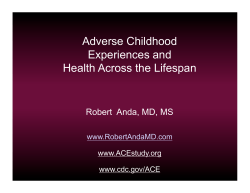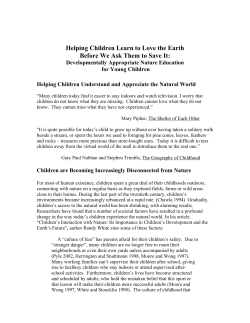
Issue Brief 1 Scanning the Horizons: Impact of Adverse Childhood Experiences on Health
Scanning the Horizons: Issue Brief 1 Impact of Adverse Childhood Experiences on Health March 2012 alliance1.org/severson/sector-trends Key Message: Advances in neurosciences and research point to a strong relationship between childhood exposure to abuse and trauma and lifelong negative health outcomes. Investments in child abuse prevention can yield long-term savings in health care costs associated with depression, addiction, heart disease, and teen pregnancy. The Adverse Childhood Experiences (ACE) study has revealed important findings that link early childhood traumas to lifelong negative physical and mental outcomes, such as addictive behavior and chronic disease. There are more than 3 million reports of child maltreatment received by state and local agencies each year. 1 In 2010, researchers estimated that the average lifetime cost per victim of nonfatal child maltreatment is $210,012. Of this total, $43,178 comes from child and adult medical costs. 2 Brain Development There also is a growing understanding of how early childhood trauma affects brain development: There is now scientific evidence that shows brain function can be altered through early abuse and neglect. Studies analyze how babies’ brains develop through interactions with their environments. When crying results in food or comfort, their neuron pathways that allow them to know how to get their needs met are strengthened. However, when crying is neglected or results in abuse, the baby learns different lessons. The strengthening of neuronal pathways under negative conditions prepares children to cope in negative environments, and their abilities to respond to nurturing and kindness may be impaired. 3 Death Early Death Whole Life Perspective Details about the ACE Study Scientific Gaps The ACE study is a large-scale population study that examines the Adverse Childhood Experiences association of traumatic Conception childhood experiences The ACE Pyramid represents the conceptual and serious household framework for the study. Centers for Disease dysfunction to multiple Control and Prevention website4 health behaviors that impact later life physical and mental health. The study has examined more than 17,000 patients who participate in routine health screenings. The study is run through a collaboration between the Centers for Disease Control and Prevention in Atlanta and Kaiser Permanente in Disease, Disability and social Problems Adoption of Health-risk Behaviors Social, Emotional, & Cognitive Impairment San Diego. The ACE study continues to reveal staggering information related to the health, social, and economic risks that result from childhood trauma.5 ACE Categories There are seven categories of childhood exposure to trauma that are asked about in the study: 1.Psychological abuse 2.Physical abuse 3.Sexual abuse 4.Mother treated violently 5.Living in a household with someone who was a substance abuser 6.Living in a household with someone with mental illness 7.Living in a household with someone who was imprisoned More than half of those participating in the ACE study reported at least one exposure, and 27 percent reported more than two categories of childhood exposures. People who experienced several types of adverse childhood experiences were more likely to have multiple health risk factors leading to unhealthy lives causing early death.6 ACE Results Compared to people who had no history of ACEs, those with histories of exposure to four or more were7: • Twice as likely to smoke • Seven times more likely to be alcoholics • Six times more likely to have had sex before the age of 15 • Twice as likely to have been diagnosed with cancer • Twice as likely to have heart disease • Four times as likely to suffer from emphysema or chronic bronchitis • Twelve times as likely to have attempted suicide • Ten times more likely to have injected street drugs Therefore, people with increased exposure to ACEs were more likely to experience the following health-related issues later in life8: • Smoking • Suicide attempts • Alcoholism • Depression • Fetal death • Illicit drug use • Ischemic heart disease • Liver disease • Intimate partner violence • Multiple sexual partners • Sexually transmitted diseases • Unintended pregnancies • Early initiation of smoking • Early initiation of sexual activity and adolescent pregnancy Strategies for Addressing ACE Study Findings • Using trauma-informed care therapy • Screening for childhood trauma when health services accessed • Providing support and stabilization services to prevent child abuse • Providing parenting classes for fathers and mothers to prevent child abuse • Promoting neighborhood revitalization to promote safety • Collaboration between human service agencies and health professionals to deliver a comprehensive continuum of care References: 1. U.S. Department of Health and Human Services, Administration for Children and Families, Administration on Children, Youth and Families, Children’s Bureau. (2011). Child maltreatment 2010. Retrieved from http://www.acf.hhs.gov/programs/cb/pubs/cm10/ 2. Fang, X., Brown, D. S., Florence, C. S., & Mercy J. A. (2012). The economic burden of child maltreatment in the United States and implications for prevention. Child Abuse & Neglect, (36)2, 156–165. Retrieved from http://dx.doi.org/10.1016/j.chiabu.2011.10.006 3. Child Welfare Information Gateway. (2009, November). Understanding the effects of maltreatment on brain development. Retrieved from http:// www.childwelfare.gov/pubs/issue_briefs/brain_development/brain_ development.pdf 4. Center for Disease Control and Prevention. (2010, October 5). Adverse childhood experiences (ACE) study: Pyramid [Web page]. Retrieved from http://www.cdc.gov/ace/pyramid.htm 5. Redding, C. (2012). The Adverse childhood experiences study [Web page]. Retrieved from http://www.acestudy.org/ 6. Felitti, V. J., Anda, R. F., Nordenberg, D., Williamson, D. F., Spitz, A. M., Edwards, V., … Marks, J. S. (1998). Relationship of childhood abuse and household dysfunction to many of the leading causes of death in adults the adverse childhood experiences (ACE) study. American Journal of Preventative Medicine, 14(4), 245–258. Retrieved from http://www. annafoundation.org/ACE%20folder%20for%20website/4RCH.pdf 7. Anda, R. F., & Felitti, V. J. (2003, April). Origins and essence of the study. ACE Reporter, 1(1). Retrieved from http://www.acestudy.org/files/ ARV1N1.pdf 8. Center for Disease Control and Prevention. (2010, September). Adverse childhood experiences (ACE) study: Major findings [Web page]. Retrieved from http://www.cdc.gov/ace/findings.htm Additional Resources 1.Center on the Developing Child, Harvard University developingchild.harvard.edu The Center on the Developing Child was founded in 2006. The Center views healthy child development as the foundation of economic prosperity, strong communities, and a just society, and their mission is to advance that vision by leveraging science to enhance child well-being through innovations in policy and practice. 2.Alliance for Children and Families Neuroscience Project Collection alliance1.org/pubs/neuroscience The Alliance for Children and Families neuroscience project explores how advancements in neuroscience will impact the ability of nonprofit human service providers to organize and deliver behavioral health services in the future. This site features three companion reports produced as part of the project. About the Alliance For Children and Families The Alliance for Children and Families is a nonprofit national membership association of private, nonprofit human service providers in the United States and Canada. The more than 350 members of the Alliance provide an array of community-based programs and services to all generations, serving close to 3.4 million people each year. The Alliance is accredited by the Council on Accreditation. ©2012 Alliance for Children and Families All Rights Reserved 12-068
© Copyright 2025





















